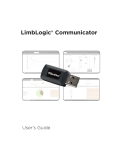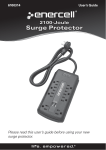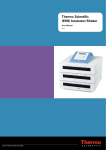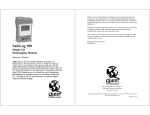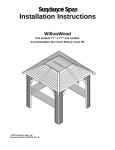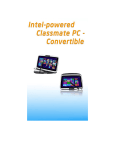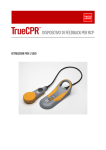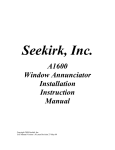Download LimbLogic® Patient Instructions
Transcript
LimbLogic® Patient Instructions LimbLogic features an electronically controlled Vacuum Pump that uses air pressure and a sealing sleeve to securely suspend your prosthesis. The fob included with the system provides you with wireless control and monitoring of the vacuum level. Please review these instructions thoroughly and contact your prosthetist if you have any questions. 1 There are no field-serviceable parts inside the Vacuum Pump. Opening the Vacuum Pump will void the warranty. This pump is only designed to move air; use of Vaseline® or similar lubricating creams inside the socket will clog the pump. Do not allow foreign substances to be pulled through the Vacuum Pump. This may impair function of your vacuum system. Do not allow acetone to contact the Vacuum Pump or fob. LimbLogic is not intended to be used as the only means of attachment of prosthesis to patient. All LimbLogic components have passed safety testing for use as medical devices. Radio enabled devices comply with United States and international guidelines for low power transceivers. If LimbLogic components will be used around safety critical devices such as pacemakers or defibrillators, consult the manufacturer for appropriate usage instructions. Consult the section on Regulatory Information for more information on safety and compliance. LimbLogic is designed for use by a single patient only. FCC NOTICE Note: This device complies with part 15 of the FCC Rules. Operation is subject to the following two conditions: (1) This device may not cause harmful interference, and (2) this device must accept any interference received, including interference that may cause undesired operation. Changes or modifications not approved by The Ohio Willow Wood Company may void the user’s authority to operate this equipment. Remarque: Le présent appareil est conforme aux CNR d’Industrie Canada applicables aux appareils radio . L’exploitation est autorisée aux deux conditions suivantes: (1) l’appareil ne doit pas produire de brouillage, et (2) l’utilisateur de l’appareil doit accepter tout brouillage radioélectrique subi, même si le brouillage est susceptible d’en compromettre le fonctionnement. 2 TABLE OF CONTENTS Page Installing the Fob Battery.......................................................................... 4 Quick-Start Guide..........................................................................................5 Fob Guide.........................................................................................................5 Charging the Vacuum Pump Battery.................................................... 6 Charging the Vacuum Pump Battery Outside the U.S.....................7 Charging the Vacuum Pump Battery in a Vehicle.............................7 Turning On the Vacuum Pump..................................................................8 Turning Off the Vacuum Pump.................................................................8 Resetting the Vacuum Pump.....................................................................8 Turning On the Fob.......................................................................................8 Changing Vacuum Set Point..................................................................... 9 Changing Usage Mode................................................................................ 9 Bilateral Indicators.......................................................................................10 Detecting a Leak........................................................................................... 11 Vacuum Pump Battery Status.................................................................. 11 Exposure to Water........................................................................................ 11 Exhaust Tube Muffler Cleaning............................................................... 12 Flushing the System.................................................................................... 12 Troubleshooting Guide.............................................................................. 13 Regulatory Information............................................................................. 17 3 Overview INSTALLING THE FOB BATTERY The fob uses a commercially available CR2032 coin cell battery. The battery that is shipped with the system must be installed prior to using the fob. The battery will normally have to be replaced every 3 months depending upon how much the fob is used. The fob case can be pried open using a small flat blade screwdriver, then snapped back together starting at the battery end and working back toward the opposite end. After the battery is replaced, the system does a quick check by illuminating all the LED indicators. If all of the LEDs do not illuminate, then either the battery or the LEDs are not working, or the battery has been installed upside-down. 4 Overview QUICK-START GUIDE 1. Turn on the Vacuum Pump. Press one time. Pump will beep once. Wait 10 seconds. 2. Turn on the fob. Press and hold center button until the yellow digits flash in a “chasing” pattern and then display the current vacuum level. The pump will operate until the preselected vacuum level has been reached. 3. To enter Standby Mode: Press for approximately 2 seconds. The chasing pattern will be displayed, then the white Standy Indicator will light. To resume vacuum regulation: Press for approximately 2 seconds. The chasing pattern will be displayed as the pump returns to Active Mode. 4. Turn off the Vacuum Pump. Press one time. Pump will beep twice. FOB GUIDE Vacuum Pump Battery Indicator 50-100% 30-50% 20-30% < 20% Bilateral Indicators Current Vacuum Level Standby Indicator (White) Up Enter Leak Indicator (Red) Down 5 Overview CHARGING THE VACUUM PUMP BATTERY The Vacuum Pump should be charged before it is used for the first time, at the end of each day of use, and when the Battery Indicator on the fob is red. Vacuum Pump Charger To AC outlet AC Adapter charging port charging plug LLV-21011 2012 13.8 0V Flashing: Charged PN-1988-H ABN: 22582837497 solid: Charging Node LED Adapter LED (indicates that AC outlet is providing power to Charger) Node LED (indicates Charger function) RED = fault SOLID = charging FLASHING = charged 1. Insert the charging plug all the way into the charging port. 2. Plug the Charger into a power outlet. The Adapter LED will light. The battery indicator on the fob will flash alternately between red and green. If the battery indicator does not light, make sure you have inserted the charging plug all the way into the port. If the Node LED is red, reset the Charger by unplugging it from the wall and plugging it back in. While charging is in progress, the Node LED will be solid. 3. When charging is complete, the Node LED will flash. Disconnect the Charger from the Vacuum Pump and from the power outlet. When you are ready for the pump to begin regulating the vacuum, either turn on the fob (refer to page 8) or press the on/off button on the Vacuum Pump. The pump will operate until the preselected vacuum level is reached. Note: if the pump has just been unplugged from the Charger, it will be in Standby Mode (refer to page 9). To resume vacuum regulation, press the on/off button one time. To turn the pump off, press the on/off button again. Use ONLY a WillowWood Charger. Use of any other charger may result in damage to the Vacuum Pump or the charger or both. With normal usage, the rechargeable battery should last for the life of the product. Do not use the Charger near water. The Charger is not waterproof. 6 Overview CHARGING THE VACUUM PUMP BATTERY OUTSIDE THE UNITED STATES If you have an international Charger, your Charger will come with a collection of prong adapters that will allow you to use your Charger in many countries. Plugging a prong set into an outlet without the Charger may expose you to dangerous voltages. Always plug the prong set into the Charger before plugging the Charger or the prong set into an outlet. CHARGING THE VACUUM PUMP BATTERY IN A VEHICLE To use a vehicle’s power to charge the Vacuum Pump, you must purchase a Power Inverter rated at 75 Watts or less to convert the vehicle’s 12V DC power to 120V AC. Examples of acceptable Power Inverters include the Digital Concepts™ 75 Watt Portable Power Inverter (available from general retailers) and the Enercell™ 75 Watt Power Inverter (available from Radio Shack®; item number 22-133). 1. Plug the Power Inverter into the vehicle’s 12V DC socket. 2. Connect the Charger to the Vacuum Pump. 3. Plug the Charger’s AC adapter into the Power Inverter’s three-pronged receptacle. Do not operate the Charger above 41˚C (105˚F). 7 Overview TURNING ON THE VACUUM PUMP on/off button Press the on/off button on the Vacuum Pump one time. The Vacuum Pump will beep once. Before turning on the fob as described below, wait 10 seconds for the pump to activate. TURNING OFF THE VACUUM PUMP Press the on/off button on the Vacuum Pump and hold for 1 second. The Vacuum Pump will beep twice. Note: if the pump has just been unplugged from the Charger, it will be in Standby Mode (refer to page 9). To resume vacuum regulation, press the on/off button one time. To turn the pump off, press the on/off button again. RESETTING THE VACUUM PUMP It is possible for a large static discharge to interrupt normal operation. Should this occur, press the on/off button on the Vacuum Pump and hold for at least 12 seconds until the unit beeps. Resetting the pump may also be required when the fob displays certain error codes (refer to page 16). TURNING ON THE FOB Current vacuum level Enter Make sure the pump is on has been on for at least 10 seconds. Press and hold the Enter (center) button for approximately 2 seconds until the yellow digits flash in a circular “chasing” pattern. The chasing pattern indicates the fob is attempting to communicate with the pump. When the fob connects to the pump, the current vacuum level will be displayed in the center. A connected fob will shut off after one minute of non-use. If the pump is off or fails to connect to the fob, the chasing pattern will end after 6 seconds, and all fob LEDs will turn off. For bilateral systems, if the fob cannot establish communications with the first pump, the fob will attempt to connect to the second pump, using the same steps as above. If communication cannot be established with either pump, the fob will shut down. 8 Overview CHANGING VACUUM SET POINT Current vacuum level Up Enter Down Make sure the fob is on and displaying the current vacuum level in the yellow digits. Press the Up or Down button for 1 second until the yellow digits flash to indicate that the Vacuum Set Point is being changed. Adjust the Vacuum Set Point as follows: • Press the Up or Down button repeatedly to adjust the Vacuum Set Point by one number at a time. or • Press and hold the Up or Down button until the desired Vacuum Set Point is displayed. Press the Enter button to apply the changes. The “chasing” pattern will be displayed while the setting is being applied. If the Enter button is not pressed, the settings will not be applied, and the fob will shut off due to inactivity in 60 seconds. CHANGING USAGE MODE Make sure the fob is on and displaying the current vacuum level. When the pump is on, it has two usage modes: Active Mode: Vacuum Pump activates as needed to maintain the vacuum level Standby Mode: allows you to temporarily suspend vacuum regulation Press and hold the Enter button to toggle the vacuum pump from one mode to the other. The “chasing” pattern will be displayed while the change in mode is being applied. Standby Indicator Enter The white Standby indicator will illuminate when the Vacuum Pump is in Standby Mode. The fob will continue to display vacuum levels while in Standby Mode. When the white Standby Indicator is not illuminated, the pump is in Active Mode. 9 Overview If the pump detects a leak, the red Leak Indicator will illuminate, the usage mode will change to Standby Mode, and the pump will beep 10 times rapidly. The pump will repeat this every 30 seconds for 6 minutes unless acknowledged by pressing the on/off button on the pump. To return to Active Mode, press and hold the Enter button. Leak Indicator Enter BILATERAL INDICATORS Bilateral Indicators Up Down If a fob is configured to support bilateral Vacuum Pumps, one of the two white indicators at the top of the fob will illuminate to show which pump (left or right) is being controlled. To switch the fob from controlling one pump to the other, press and hold the Up and Down buttons together for approximately 1 second. The “chasing” pattern will be displayed, and the indicator light will switch from one side to the other while communication with the other pump is being established. If communication is established, the displays and controls are similar to those for a unilateral system. If no communication can be established, the fob will return to controlling the pump that it controlled prior to the attempted switch. 10 Overview DETECTING A LEAK Leak Indicator If the Vacuum Pump detects a leak, the red Leak Indicator will illuminate, and the system will enter Standby Mode. At this time, the pump will make 10 short beeps. This will repeat every 30 seconds for 6 minutes unless acknowledged by pressing the on/off button on the pump. If the Leak Indicator appears when you initially don your prosthesis, restart the pump. If the Leak Indicator appears frequently while you are walking, contact your prosthetist. To resume automatic vacuum regulation after a leak has been detected, press the on/off button on the Vacuum Pump one time or press the Enter button on the fob. VACUUM PUMP BATTERY STATUS Vacuum Pump Battery Indicator The Battery Indicator flashes alternatively between red and green when the Vacuum Pump battery is charging. The level of charge is indicated as follows: • Solid green: Vacuum Pump battery is between 50% and 100% charged. • Flashing green: Vacuum Pump battery is between 30% and 50% charged. • Solid red: Vacuum Pump battery is between 20% and 30% charged. • Flashing red: Vacuum Pump battery is less than 20% charged. The battery should be charged when possible. The pump will shut down when the battery level reaches 0%. • At 10% the pump will start to beep 3 times every 30 seconds. This will repeat for 6 minutes unless acknowledged by pressing the on/off button on the pump. EXPOSURE TO WATER The Vacuum Pump is waterproof in fresh water up to a depth of 10 feet or 3 meters for up to 12 hours. The Vacuum Pump should not be submersed in salt water or any other corrosive liquids. Be sure to dry off the Vacuum Pump if it is exposed to rain or other moisture. The fob and Charger should not be exposed to water or other liquids. 11 Overview EXHAUST TUBE MUFFLER CLEANING Using a flat blade screwdriver, remove the Exhaust Tube Fitting from the pump housing. Do not lose the o-ring from the fitting. Exhaust Tube Fitting Clear the clog in the tube by running water or by gently blowing compressed air through the tube. If the clog cannot be cleared, contact your prosthetist for a replacement Exhaust Tube from WillowWood (LLV-21080). If the pump must be used before the replacement tube can be installed: 1. Remove the existing tube from the Exhaust Tube Fitting. 2. Cut the existing tube just past the Muffler. 3. Connect the Exhaust Tube Fitting to the section of tube that does not have the Muffler. The pump will function normally, but at a slightly higher noise level. Exhaust Tube Fitting Muffler Cut here FLUSHING THE SYSTEM In some situations it may become necessary to flush the system. Using a flat blade screwdriver, remove the Exhaust Tube Fitting from the pump housing. Do not lose the o-ring from the fitting. Install the drain tube and flush the system with alcohol. 12 Overview TROUBLESHOOTING GUIDE If you are still experiencing a problem after consulting this guide, contact your prosthetist. Problem Action The pump does not beep when the on/off button is pressed and the Charger is not connected to the pump. • The pump’s internal battery may not be charged. Charge the pump with the Charger for at least 30 minutes and try again. • The on/off button could be damaged. Verify that the rubber boot is intact and hasn’t been torn from impact. Contact your prosthetist if the switch needs to be replaced. • The pump may have been exposed to a large static charge. Press and hold the on/off button on the pump until you hear a beep (approximately 12 seconds). Pressing the pump button does not start the pump. • The pump’s internal battery may not be charged. Charge the pump with the Charger for at least 30 minutes and try again. • The pump may have been exposed to a large static charge. Press and hold the on/off button on the pump until you hear a beep (approximately 12 seconds). • The pump may be partially stalled. Refer to the “Pump Stall” error code information on page 16. Pump battery does not maintain charge for a full day. • Ensure that the system is properly sealed. • Ensure that the battery has been charged for at least 4 hours. • The pump may have been exposed to a large static charge. Press and hold the on/off button on the pump until you hear a beep (approximately 12 seconds). • Ensure that your socket does not leak excessively. The pump makes a “zip zip zip” sound as it controls the vacuum. Contact your prosthetist. Pressing the center button of the fob does not cause the yellow LEDs to light in a “chasing” pattern. The battery is likely dead and must be replaced per the instructions on page 4. Vacuum Level display on fob does not respond to changes in vacuum level in your socket. Contact your prosthetist. continued on next page 13 Overview Problem Action The fob does not communicate with the pump. The “chasing” pattern of LEDs ends after 6 seconds, and the LEDs turn off. • Wait one minute for the fob screen to turn off. Make sure the pump is on by pressing the on/off button and verify that the pump beeps once. Listen for about 30 seconds to make sure that the pump doesn’t quickly beep twice and turn off, which indicates a battery problem. Press the fob center button again. • The fob may be too close or too far from the pump. Place the fob about 2 feet away from the pump, and press the fob center button again. • The pump’s internal battery may not be charged. Charge the pump with the Charger for at least 30 minutes and try again. • The pump may have been exposed to a large static charge. Press and hold the on/off button on the pump until you hear a beep (approximately 12 seconds). • Do you have the correct fob-pump combination? The fob and pump are electronically matched during the production process. Ask your prosthetist to contact WillowWood with the serial number of the fob and serial number of the pump to verify that the set is matched. The Adapter LED on the Charger does not illuminate when plugged into the wall. • The AC electricity to the wall outlet may not be turned on. Try plugging the Charger into a different non-switched wall outlet or in another room. • The configurable prong may not be seated properly in the back of the Charger’s AC Adapter. Unplug the Charger from the AC outlet. Remove the Charger’s prong using the sliding latch on the back of the adapter. Verify that the metal contacts are springy and are not completely flat against the adapter. Re-install the plug prongs. • If the problem persists, contact your prosthetist. The Node LED on the Charger does not light or blink when the Charger is plugged into vacuum pump and AC outlet. Contact your prosthetist. The Node LED is red. Reset the Charger by unplugging it from the wall and plugging it back in. continued on next page 14 Overview Problem Action The pump runs repeatedly. Using a flat blade screwdriver, remove the Exhaust Tube Fitting from the pump housing. Do not lose the o-ring from the fitting. Install the drain tube and flush the system with alcohol. The pump beeps but does not run. The Muffler on the Exhaust Tube may be clogged. Clean the Muffler as described on page 12. 15 Overview Error Codes If the vacuum pump’s controller detects an error from which it cannot recover, the fob display will alternate between the letters “Er” and a two-digit error code. Refer to the chart below for the type of error indicated by each code and the corresponding action. Problem Description Cause Action 01 Pump stall Possibly debris or lubricant stuck in pump Reset the pump by pressing and holding the pump’s on/off button for approximately 12 seconds until you hear a beep, then flush the system with alcohol (refer to Flushing the System on page 12). 02 Temp out of range Pump temperature less than -20˚ C or greater than 70˚ C Allow pump temperature to return to operating range, then reset the pump by pressing and holding the pump’s on/off button for approximately 12 seconds until you hear a beep. 03 Motion fail Motion sensor failure Contact your prosthetist. 04 ADC fail Analog Digital Converter failure Contact your prosthetist. 05 Memory Memory failure Reset the pump by pressing and holding the pump’s on/off button for approximately 12 seconds until you hear a beep. If problem persists, contact your prosthetist. 06 Radio BLE Radio failure Contact your prosthetist. 07 Vacuum Vacuum Sensor failure Contact your prosthetist. 08 Battery Battery monitoring circuit failure Contact your prosthetist. 16 Technical Information REGULATORY INFORMATION Return this product to the factory for proper dispoal. LimbLogic Fob This product contains a user replaceable lithium battery. Replace only with user replaceable CR2032 batteries. Discard of discharged batteries in accordance with local regulations. Observe polarity markings on the battery and the fob housing when replacing the battery. This product complies with: EN 60601-1-2:2007, IEC 60601-1-2 ED. 3.0, and IEC 60601-1:2005 +CORR.1(2006) + CORR. 2 (2007). IEC 60601-1 Classifications: Internally powered Degree of protection against electrical shock – Type BF Applied Part In addition to the above compliances, this device complies with EN55022:1998/A1:2000/A2:2003 Class B ITE emissions requirements and all requirements for Low Interference Potential Devices (LIPD) and compliance with the requirements for a General User Licence (GUL). LimbLogic Vacuum Pump This product contains a rechargeable Lithium Ion Battery. Use ONLY a Willow Wood charger. Use of other chargers may result in harm to the device, the user, or both and void the warranty. Blocking or plugging the exhaust port of the vacuum control assembly will prevent proper operation of the vacuum pump. The LimbLogic Vacuum Pump is intended for use on a single patient. Use of the system with multiple patients could lead to cross contamination between patients. The LimbLogic vacuum system has been designed for and clinically tested as a suspension aid. It has not been clinically tested for wound healing or other uses. WillowWood does not currently support the use of the LimbLogic for uses other than suspension. Use only the bolts supplied by WillowWood. All testing for the LimbLogic vacuum system has been tested with the bolts included with the system. Use of other bolts could result in mechanical failure. This product complies with: EN 60601-1-2:2007, IEC 60601-1-2 ED. 3.0, IEC 60601-1:2005 +CORR.1(2006) + CORR. 2 (2007), CEI/IEC 60529:1989+A1:1999 rating IPX8 (3 meters for 8 hours in fresh water), and ISO 10328:2005. IEC 60601-1 Classifications: Internally powered/Powered from Class II Power Supply Degree of protection against electrical shock – Type BF Applied Part This product complies with the requirements of ISO 10328. In addition to the above compliances, this device complies with EN55022:1998/A1:2000/A2:2003 Class B ITE emissions requirements and all requirements for Low Interference Potential Devices (LIPD) and compliance with the requirements for a General User Licence (GUL). 17 Technical Information LimbLogic Battery Charger This product is designed to work with WillowWood products specifically designed for its use. Use WillowWood charger part number LLV-21011. Use with other products may result in harm to the device, the user, or both and void the warranty. Refer to product manuals to verify compatibility with this charger before attempting to use this charger with the product. Electrical Ratings: Rated input: 100 – 240 Vac, 0.6 A, 47 – 63 Hz Rated output: 13.8 Vdc, 2.6 A This product complies with: EN 60601-1-2:2007, IEC 60601-1-2 ED. 3.0, and IEC 60601-1:2005 +CORR.1(2006) + CORR. 2 (2007) and meets the “ICNIRP GUIDELINES FOR LIMITING EXPOSURE TO TIME-VARYING ELECTRIC AND MAGNETIC FIELDS (1 HZ – 100 kHZ):2010”. FCC AND IC COMPLIANCE INFORMATION (FOR THE FOB AND THE VACUUM PUMP) Note: This equipment contains: FCC ID XDULE40-S2 IC: 8456A-LE4S2) Contient le module d’émission IC: 8456A-LE4S2 FOR THE CHARGER This equipment contains: FCC ID U3V-LLV21011 This device complies with Part 15 of the FCC Rules. Operation is subject to the following two conditions: 1. This device may not cause harmful interference, and 2. This device must accept any interference received, including interference that may cause undesired operation. Radio Frequency Interference Statement This is a Class B product. In a domestic environment, this product may cause radio interference in which case the user may be required to take adequate measures. Note: This equipment has been tested and found to comply with the limits for a Class B digital device, pursuant to part 15 of the FCC Rules. These limits are designed to provide reasonable protection against harmful interference in a residential installation. This equipment generates, uses and can radiate radio frequency energy and, if not installed and used in accordance with the instructions, may cause harmful interference to radio communications. However, there is no guarantee that interference will not occur in a particular installation. If this equipment does cause harmful interference to radio or television reception, which can be determined by turning the equipment off and on, the user is encouraged to try to correct the interference by one or more of the following measures: —Reorient or relocate the receiving antenna. —Increase the separation between the equipment and receiver. —Connect the equipment into an outlet on a circuit different from that to which the receiver is connected. —Consult the dealer or an experienced radio/ TV technician for help. 18 Technical Information This digital apparatus does not exceed the Class B limits for radio noise emissions from digital apparatus set out in the Radio Interference Regulations of the Canadian Department of Communications. REMARQUE: Cet équipement a été testé et déclaré conforme aux les règles de ICES-001. Ces limites ont pour objectif de fournir une protection raisonnable contre les interférences nuisibles dans une installation résidentielle. Cet équipement génère, utilise et rayonne de l’énergie de fréquence radio et peut nuire aux communications radio s’il n’est pas installé et utilisé en accord avec le mode d’emploi. Cependant, il n’est pas garanti que des interférences surviennent dans une installation particulière. Si l’équipement cause des interférences nuisibles à la réception radio ou télévision, qui peuvent être localisées en allumant ou en éteignant l’équipement, l’utilisateur est encouragé à corriger les interférences en employant une ou plusieurs des mesures suivantes: —Réorienter ou déplacer l’antenne de réception. —Séparer davantage l’équipement et le récepteur. —Connecter l’équipement à une prise de courant située sur un circuit différent de celui du récepteur. —Demandez assistance à un revendeur ou un technicien expérimenté dans le domaine radio/TV. ELECTROMAGNETIC COMPATIBILITY Medical electrical equipment needs special precautions regarding electromagnetic compatibility (EMC) and needs to be installed and put into service according to the EMC information provided in this user manual. Portable and mobile radio frequency (RF) communications equipment can affect medical electrical equipment. Guidance and Manufacturer’s Declaration Electromagnetic Emissions LimbLogic is intended for use in the electromagnetic environments specified below. The customer or the user of the LimbLogic should assure it is used in such an environment. Emissions test Compliance Electromagnetic environment - guidance RF emissions CISPR 11 Group 2 LimbLogic must emit electromagnetic energy in order to perform its intended function. Nearby electronic equipment may be affected. RF emissions CISPR 11 Class B Harmonic emissions IEC 61000-3-2 Class A Voltage fluctuations/ flicker emissions IEC 61000-3-3 Complies LimbLogic is suitable for use in all establishments, including domestic establishments and those directly connected to the public low-voltage power supply network that supplies buildings used for domestic purposes. Emissions from this device comply with the recommendations of the ICNIRP’s “Guidelines for Limiting Exposure to Time-Varying Electric and Magnetic Fields (1 Hz - 100 kHz). Health Physics 99(6):818-836; 2010. 19 Technical Information Guidance and Manufacturer’s Declaration Electromagnetic Immunity LimbLogic is intended for use in the electromagnetic environments specified below. The customer or the user of the LimbLogic should assure it is used in such an environment. Immunity test IEC 60601 test level Compliance level Electromagnetic environment guidance Electrostatic discharge (ESD) IEC 61000-4-2 ± 6 kV contact ± 6 kV contact ± 8 kV air ± 8 kV Air Floors should be wood, concrete, or ceramic tile. If floors are covered with synthetic material, the relative humidity should be at least 30%. Electrical fast transient/ burst IEC 61000-4-4 ± 2 kV for power supply lines ± 2 kV on power supply lines ± 1 kV on input/ output lines ± 1 kV on Input/ output lines Surge IEC 61000-4-5 ± 1 kV differential mode ± 1 kV differential mode ± 2 kV common mode ± 2 kV common mode < 5% UT < 5 % UT (>95 % dip in UT) for 0,5 cycle (>95 % dip in UT) for 0,5 cycle 40% UT 40% UT Voltage dips, short interruptions and voltage variations on power supply input lines IEC 61000-4-11 Power frequency (60% dip in (60% dip UT) for in UT) for 5 cycles 5 cycles 70% UT 70% UT (30% dip in UT) for 25 cycles (30% dip in UT for 25 cycles < 5% UT < 5% UT (>95 % dip in UT) for 5 sec (>95 % dip in UT) for 5 sec 3 A/m 3 A/m (50/60 Hz) magnetic field IEC 61000-4-8 Mains power quality should be that of a typical commercial or hospital environment. Mains power quality should be that of a typical commercial or hospital environment. Mains power quality should be that of a typical commercial or hospital environment. If the user of the LimbLogic requires continued operation during mains interruptions, it is recommended that the LimbLogic be powered from an uninterruptible power supply or a battery. Power frequency magnetic fields should be at levels characteristic of a typical location in a typical commercial or hospital environment. NOTE UT is the a.c. mains voltage prior to application of the test level. 20 Technical Information Guidance and Manufacturer's Declaration Electromagnetic Immunity LimbLogic is intended for use in the electromagnetic environments specified below. The customer or the user of the LimbLogic should assure it is used in such an environment. Immunity test IEC 60601 Compliance Electromagnetic environment test level Level guidance Portable and mobile RF communications equipment should be used no closer to any part of the LimbLogic, including cables, than the recommended separation distance calculated from the equation applicable to the frequency of the transmitter. Recommended separation distance Conducted RF 3 Vms IEC 61000-4-6 150 kHz to 80 MHz 3V 3 V/m Radiated RF IEC 61000-4-3 80 MHz to 2.5 GHz 3 V/m 80 MHz to 800 MHz 800 MHz to 2.5 GHz where P is the maximum output power rating of the transmitter in watts (W) according to the transmitter manufacturer and d is the recommended separation distance in meters (m). Field strengths from fixed RF transmitters, as determined by an electromagnetic site survey,a should be less than the compliance level in each frequency range.b Interference may occur in the vicinity of equipment marked with the following symbol: NOTE 1 At 80 MHz and 800 MHz, the higher frequency range applies. NOTE 2 These guidelines may not apply in all situations. Electromagnetic propagation is affected by absorption and reflection from structures, objects and people. a Field strengths from fixed transmitters, such as base stations for radio (cellular/cordless) telephones and land mobile radios, amateur radio, AM and FM radio broadcast and TV broadcast cannot be predicted theoretically with accuracy. To assess the electromagnetic environment due to fixed RF transmitters, an electromagnetic site survey should be considered. If the measured field strength in the location in which the LimbLogic is used exceeds the applicable RF compliance level above, the LimbLogic should be observed to verify normal operation. If abnormal performance is observed, additional measures may be necessary, such as reorienting or relocating the LimbLogic. b Over the frequency range 150 kHz to 80 MHz, field strengths should be less than 3 V/m. 21 Technical Information Recommended separation distances between portable and mobile RF communications equipment and the LimbLogic LimbLogic is intended for use in an electromagnetic environment in which radiated RF disturbances are controlled. The customer or the user of LimbLogic can help prevent electromagnetic interference by maintaining a minimum distance between portable and mobile RF communications equipment (transmitters) and the LimbLogic as recommended below, according to the maximum output power of the communications equipment. Separation distance according to frequency of transmitter m Rated maximum output power of transmitter W 150 kHz to 80 MHz 80 MHz to 800 MHz 800 MHz to 2.5 GHz 0.01 0.12 0.12 0.23 0.1 0.38 0.38 0.73 1 1.2 1.2 2.3 10 3.8 3.8 7.3 100 12 12 23 For transmitters rated at a maximum output power not listed above, the recommended separation distance d in meters (m) can be estimated using the equation applicable to the frequency of the transmitter, where P is the maximum output power rating of the transmitter in watts (W) according to the transmitter manufacturer. NOTE 1 At 80 MHz and 800 MHz, the separation distance for the higher frequency range applies. NOTE 2 These guidelines may not apply in all situations. Electromagnetic propagation is affected by absorption and reflection from structures, objects and people. 22 Technical Information USER PROFILE Prosthetist user LimbLogic is intended to be used for assembly of prosthetic devices by a certified prosthetist or prosthetic technician. Patient user LimbLogic is intended for use by patients meeting the following conditions. – Age: Any. Determined by clinician’s evaluation of patient competence and health. – Weight: (Body weight plus any loads normally or routinely carried cannot exceed these weight limits.) <350 lb (160 kg) for U.S. Activity K Level 2 or 3 <300 lb (136 kg) for U.S. Activity K Level 4 – Health: Activity Level K2-K4 – Nationality: Any – Mentally competent to operate system as judged by prosthetist. PERFORMANCE CHARACTERISTICS Capabilities: – 2 year warranted service life – Vacuum setting up to 68 kPa. For ease of use, this range has been divided into twenty even steps between 1 and 20. – Indoor & Outdoor usage – The LimbLogic Controller (pump) is waterproof in fresh water to a depth of 3 meters (10 feet) for up to 12 hours at a time. – Operating temperature range: 0 °C to +50 °C – Transportation and storage temperature range: -20 °C to +50 °C – Humidity range: 10 % to 90 % RH, non condensing – Transportation and storage humidity range: 0 % to 100 % RH, non condensing – Altitude range: 0 to 5500 feet – Transportation and storage altitude range: -500 to 20,000 feet Restrictions: – LimbLogic must not be used in salt water or any other corrosive environment. – At temperatures below freezing, condensation will form and freeze in the pump preventing further operation until warmed. – The hand-held fob, communicator, and charger should not be exposed to water. – Frequency of use: Daily for 16 hours / day or as needed. PHYSICAL MEASUREMENTS Module Dimensions (mm) Fob with Battery 38L x 31W x 8H 17 Pump 36H x 74DIA 231 Charger Wall Transformer 86L x 56W x 37H 261 23 Weight (gms) The Ohio Willow Wood Company 15441 Scioto Darby Road Mt. Sterling, OH 43143 phone 740.869.3377 / 800.848.4930 fax 740.869.4374 www.willowwoodco.com Ohio Willow Wood Company B.V Keizersgracht 62/64 1015 CS Amsterdam The Netherlands PN-2014-N 1 MAY 2013 Covered by one or more Patents: US 8,242,879; 24 8,016,892; 7,947,085; 7,914,586 Other Patents Pending



























